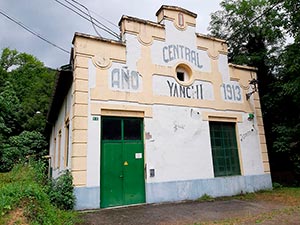Hydroelectric power plants in the Bidasoa basin
Yanci II Power Station - Electra Aranaz
The Yanci II power plant is located in the district of Berrizaun (Igantzi) very close to the Bidasoa greenway. The water of the Arrata river is diverted in the municipality of Arantza and is conducted to its destination through a 3,800 meter canalization. This hydraulic exploitation came into operation in 1913, operated by the company Electra Aranaz to send electricity to Guipúzcoa, with Papelera Española and the Railway from San Sebastián to the French border as the first customers. The project was commissioned to the engineer Miguel Berazaluce Elcarte.
The powerhouse, which houses two generating sets, has an interesting façade with a marked ascending sense, through the arrangement of simulated ashlar reinforcement at the corners, vertical bands on the wall and a stepped top. The upper part of the façade is resolved with vertical and horizontal bands in slight projection that enclose an oculus and the typography with the name of the business -originally Electra Aranaz- and the year of inauguration. These elements are combined with semicircular ornamental details that enrich the staggered finial. In the lower half there is a door and a linteled window with a soberly composed crown. The chromatic alternation contributes to emphasize the different elements used in the articulation of the facade.
Along the Bidasoa greenway there are three other power plants, in addition to Yanci II, which makes them a potential tourist attraction resource , which can at least be visited at knowledge dissemination by means of panels explaining their historical, economic and technological values. In the section between Sunbilla and Berrizaun is the Mourgues power station, commissioned in the 1910s, from which you can see the entire work of diversion of water from the Bidasoa River. In the section between Bera and Guipúzcoa are located Las Nazas, one of the oldest in the area, in operation in 1902, which supplied energy to Irún, Hondarribia and several towns in the south of France; and Endarlaza, now abandoned. In addition, in the same neighborhood of Berrizaun, on the other side of the river, stands Yanci I, a huge building from 1927 that is a good sample of the progressive evolution towards rationalism in the architecture of hydroelectric power plants.
ALEGRÍA SUESCUN, D., "El molino harinero de Zubieta. Evolución histórica", in Notebooks of ethnology and ethnography of Navarren.º 82 (2007), pp. 5-15.
APEZTEGUÍA ELSO, M. and IRIGARAY SOTO, S., "El Ecomuseo del Molino de Zubieta (Navarra): experiencia pionera en la recuperación y musealización de una instalación preindustrial", in Museum: Magazine of the association Profesional de Museólogos de España (Professional Association of Museologists of Spain)No. 4 (1999), pp. 181-192.
BERAZALUCE ELCARTE, M., "La industria hidro-eléctrica en Navarra", in Rafael Guerra (ed.), Navarra. Ayer, hoy y mañana, Pamplona, Diputación Foral de Navarra, 1933.
HERREROS LOPETEGUI, S. (coord.), Centrales Hidroeléctricas en Navarra (1898-2018), Pamplona, Gobierno de Navarra, 2020.
Map of status based on El agua en Navarra, Pamplona, Caja de Ahorros de Navarra, 1991.











